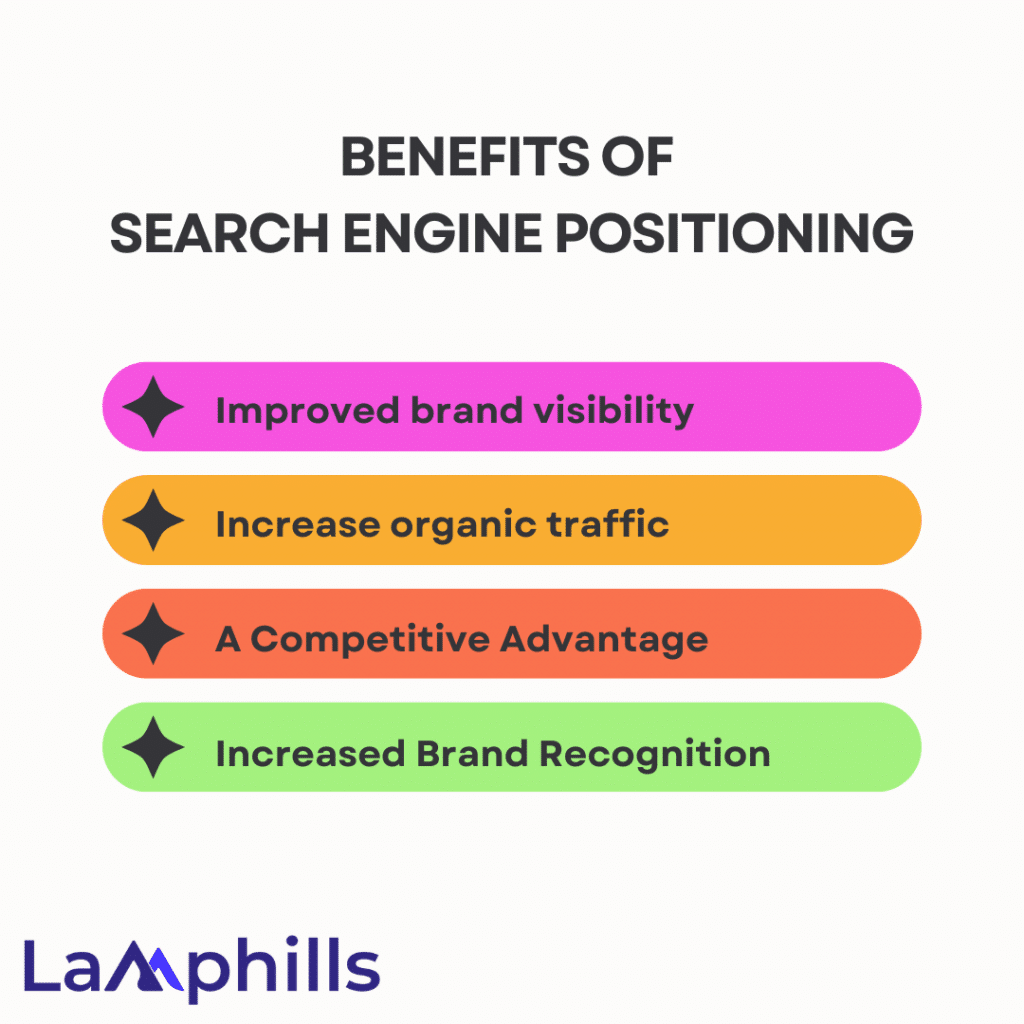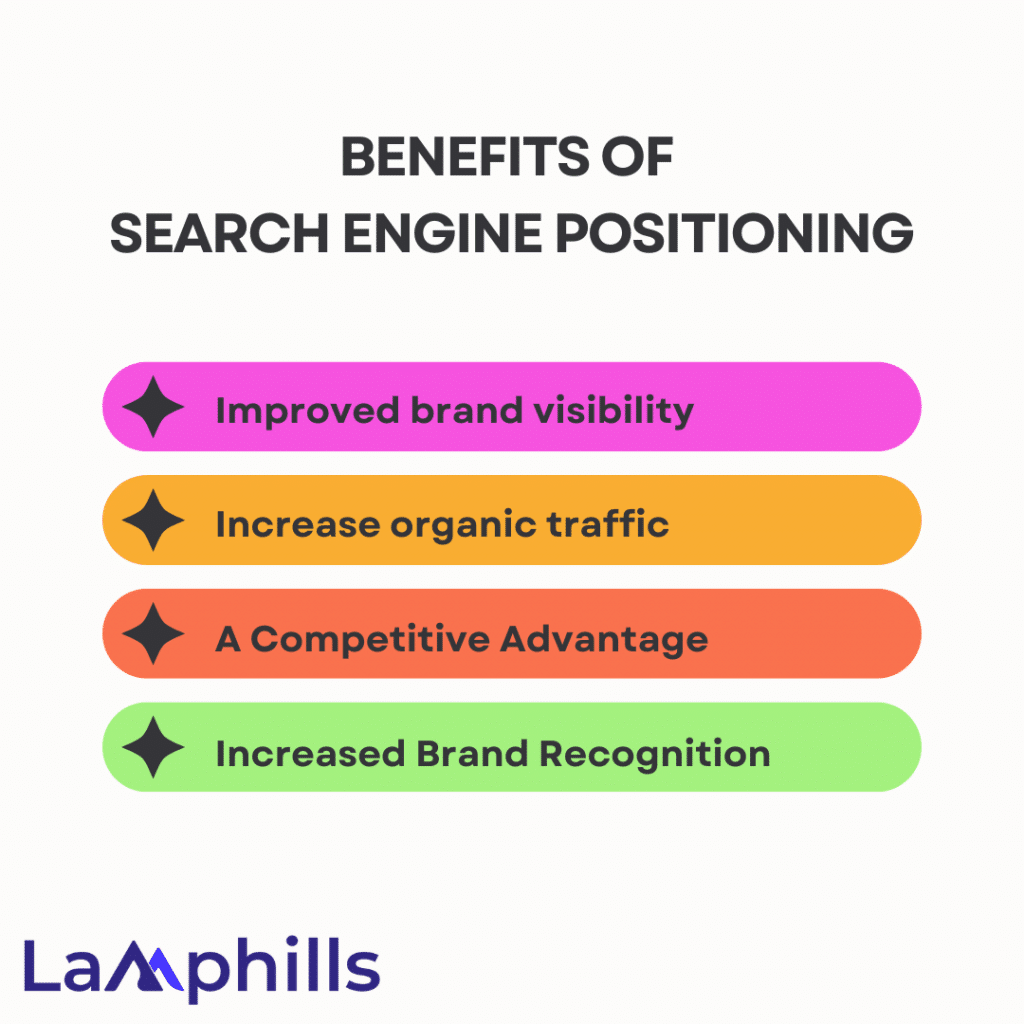When I initially got into digital marketing, the concept of search engine positioning looked both exciting and daunting. I wanted my website to rank at the top of Google’s search results, just like many of you. However, I quickly discovered that achieving this goal needed more than simply placing keywords into my article. It required a strategic strategy, technological competence, and a thorough understanding of how search engines operate. In this article, I’ll offer the insights and methods I’ve developed over the years to assist you improve your search engine positioning in 2024.
What is Search Engine Positioning?
Search engine positioning, often known as search engine optimization (SEO), is one of the most significant aspects of SEO.
It entails optimizing specific pages of your website to improve search engine rankings. As a result, your brand’s visibility improves and you get more organic traffic.
Users are more inclined to click on listings at the top of the first page of search results. Backlinko’s search engine positioning experts discovered that the top three Google results receive 54.4% of all clicks.
And fewer people click on results that appear deeper down the SERPs. The top result receives approximately 27.6% of all clicks, whilst the tenth result receives only 2.4%.
The purpose of search engine positioning is to get your content at the top of the list by boosting parameters like:
- Content quality: This is how well your content provides value and relevance to the topic.
- Relevant backlinks: The amount and quality of links from other related websites that point to your site
- Mobile-friendliness: How quickly your page opens on cell phones and how easy it is to navigate
- Page performance: This is how quickly (or slowly) your page loads and functions for users.
Key Takeaways
- Quality Content is Important: Prioritize user purpose, keyword research, and originality.
- On-Page and Technical SEO Matter: Improve title, meta description, site performance, and mobile compatibility.
- Backlinks Increase Authority: Use guest blogging, broken link building, and content marketing to get high-quality backlinks.
- User Experience Affects Rankings: Provide easy navigation, readable material, and interesting media.
- Stay Ahead with Advanced Strategies: Optimize for voice search, use AI, and improve your website’s E-A-T.
Benefits of Search Engine Positioning

Strategic search engine positioning is critical to establishing a strong online presence.
Here’s what it offers you:
#1. Improved brand visibility
Search engine positioning can help your website rank higher in the SERPs by optimizing a single page for a set of relevant keywords, boosting content quality, and improving user experience (UX).
And, as previously said, higher places in search results generate more clicks.
#2. Increase organic traffic
Higher rankings help to increase organic traffic to your websites.
Search engine positioning is a low-cost, long-term strategy for attracting new customers. Organic listings generate free traffic, unlike pay-per-click (PPC) models.
Not every website visitor will make a purchase from you right away. However, search engine positioning allows you to reach various prospective customers where they are by presenting them with information that represents their different search intents.
- Navigational: The searcher is seeking for a certain page or website.
- Informational: The searcher seeks information about a topic.
- Commercial: the searcher is exploring products and services.
- Transactional: The searcher is looking for specific products and services and is willing to buy.
This fosters an authentic relationship and trust between consumers and your brand, naturally moving them along their customer journey.
#3. A Competitive Advantage
Regardless of how niche your industry is, you will face competition from comparable brands for the attention of the same target demographic. However, only one website can achieve the top ranking for a keyword.
Devoting time and resources to search engine positioning can provide you with an advantage over competitors who do not prioritize it. When your pages rank higher than your competitors’, traffic that might otherwise go to them is more likely to come your way.
For example, a dry ice company that supplies to a specific region may have little competition. To establish itself as the leading brand in the area, consider optimizing its service page using keyword-oriented features such as:
- Ordering Process Steps
- Pricing and Payment Information
- Quality assurance information.
- Delivery logistics
- Safety Information
- Customer testimonials.
- Contact information
- Frequently Asked Questions
- Calls for action
Targeting relevant keywords while giving useful information and value can help the dry ice company rank higher than competitors whose service pages have sparse content.
As another example, imagine you’re an online reseller of Nike “Panda Dunks,” one of the world’s most popular sneakers. Here, the search landscape is extremely competitive.
Your Panda Dunks collection page must stand out in ways that the competition does not. Perhaps they don’t contain testimonials or commonly asked questions, and their page speed is slow.
As a result, you’d focus on optimizing your page to address these elements to outperform your competitors.
#4. Increased Brand Recognition
Creating content that indicates Experience, Expertise, Authority, and Trustworthiness (E-E-A-T) helps you preserve your reputation in the eyes of both Google Quality Raters and users. This, in turn, may indirectly improve your rankings.
Consistently maintaining those top positions also helps to improve your reputation. Seeing your brand name appear first in relevant searches indicates that your brand is trustworthy. This can have a good effect when it comes time to buy.
Key Components of Search Engine Positioning

#1. Quality Content
Quality content is the cornerstone of every effective SEO campaign. Google’s algorithms prefer content that is relevant, informative, and interesting. When developing material, consider:
- User Intent: Learn about your audience’s search terms and generate content that addresses their questions.
- Keyword Research: Use tools such as Ahrefs and SEMrush to find high-volume keywords related to your area.
- Originality: Ensure that your content is distinctive and provides new insights.
#2. On-page SEO
of-page SEO is the process of optimizing individual pages of your website so that they rank higher. Key features include:
- Title Tags and Meta Descriptions: Create engaging, keyword-rich titles and descriptions.
- Header Tags (H1, H2, H3): Headers help arrange your content and make it easier for search engines to interpret.
- Internal Linking: Provide links to other relevant pages on your website to improve navigation and link equity.
#3. Technical SEO
Technical SEO focuses on improving your website’s infrastructure. Important aspects include:
- Site Speed: Ensure that your website loads swiftly. According to Google, 53% of mobile users abandon websites that take more than three seconds to load.
- Mobile-Friendly: Ensure that your site is responsive and works properly on all devices.
- XML Sitemap: Submit an XML sitemap to assist search engines index your website more effectively.
#4. Backlinks
Backlinks, or inbound links, are critical for increasing your site’s authority and rating. Strategies for getting backlinks include:
- Guest Blogging: Create articles for trustworthy websites in your field.
- Broken Link Building: Identify and replace broken links on other websites with links to your own content.
- Information Marketing: Create shareable information, like as infographics and research reports, that people would want to link to.
Read Also: What Is Link Farming and Why Is It Considered a Black Hat SEO Tactic?
#5. User Experience (UX)
User experience is very important in SEO. Google evaluates user experience using indicators such as bounce rate, time on site, and pages per session. To enhance the user experience:
- Straightforward Navigation: Make sure your website is straightforward to explore.
- Readable Content: Use legible fonts and break up material with graphics and headlines.
- Engaging Media: Use movies, graphics, and interactive features to keep users interested.
Read Also: Product Experience 101: What You Need to Know
Search Engine Positioning vs. SEO: Understanding the Differences
While search engine positioning and SEO are similar concepts, they are not the same.
#1. Main Focus
SEO is a holistic approach to increasing search exposure and performance throughout your entire website. It addresses various issues, such as:
- Keyword Research
- Content creation
- Website architecture and user experience
- Page Speed
- Conversion rate optimization
Assume you’re an athleisure retailer. To attract a larger audience and establish your site as a go-to resource for athleisure, your SEO strategy would most likely include creating a range of content, such as landing pages, user testimonials, and insightful blog pieces on fashion and sports trends.
On the other hand, search engine positioning is a subset of SEO that focuses on specific sites to increase their exposure in search results.
Using the same example, search engine positioning entails focusing on a collection or product page that you want to improve ranks for, such as fitness shorts. By customizing that page with exercise shorts-related keywords, useful material, internal links to linked pages, and increasing page performance, you hope to improve its ranking for the precise target terms.
#2. Timeline
SEO is a long-term strategy that aims to improve your website’s overall quality, relevancy, and ranks. Even Google states that SEO can take four months to a year to produce results.
However, with search engine positioning, you should expect to see position results for your website pages within a few days of Google crawling, though it could take a month or longer.
However, this does not guarantee that your pages will rank high right away. So, any modifications made to your page will take effect within a few days.
You might possibly speed up the process by instructing Google to index or reindex your page immediately after making changes in the Google Search Console.
To request that Google re-index your page once you’ve optimized it, type your page URL into the search bar at the top of Search Console.
Press the “Enter” key on your keyboard, and the tool will display the indexing status.
Even if the page has previously been indexed, you can click “Request Indexing” to notify Google that your website has changed and should be crawled again.
Advanced Search Engine Positioning Strategy for 2024
#1. Voice Search Optimization
With the proliferation of speech-activated devices, optimizing for voice search has become increasingly vital. Voice searches are usually lengthier and more conversational. Focus on:
- Long-Tail Keywords: Use natural-language terms that people are more likely to say than type.
- Featured Snippets: Try to rank for featured snippets, which are frequently read out by voice assistants.
#2. AI and Machine Learning
Search engines use AI and machine learning to provide more relevant search results. To stay ahead,
- Understanding Google’s BERT Algorithm: BERT helps Google understand the context of words in searches. Optimize your content based on natural language and context.
- Using Artificial Intelligence Tools: Use AI-powered tools, such as Clearscope, to optimize your content and analyze keywords.
#3. E-A-T (expertise, authority, trustworthiness)
Google prioritizes E-A-T when ranking websites. To improve your E.A.T:
Expert Content: Share content created by specialists in your industry.
Author Bios: Provide extensive author bios to build credibility.
Trust Signals: Include trust signals like customer testimonials, case studies, and certifications.
How Can You Check A Page’s Position in Search Engines?
Visit the Google Search Console website to monitor your Google search positioning.
Google’s free service reports and tools provide information on how Google sees your site, as well as insights into performance, traffic, and click-through rate. These data and tools can also help you maintain and fix the visibility of your search results.
A useful tip: Google Search Console displays the keywords for which you rank, as well as the specific pages where Google found spam, indexing, or other difficulties. This information can aid you with your optimization efforts.
Your rating may vary as search engines continue to index fresh content. Monitor your performance to determine where to direct your efforts.
Software tools like Ahrefs and SEMrush can help you analyze your performance and placement in greater depth.
Using a Digital Marketing Plan Template.
A digital marketing plan template will help you streamline your SEO efforts. This form can help you organize your strategies, establish quantifiable targets, and monitor your progress. With a clear plan in place, you can stay focused and ensure that all areas of your SEO approach are addressed.
I recall working on a project where we struggled with poor search engine results despite putting in a lot of effort. Following a thorough assessment, we identified various technical faults and content deficiencies. By resolving these difficulties and employing a more systematic strategy, we observed a significant boost in our rankings and traffic. This experience demonstrated the value of a comprehensive and well-planned SEO approach.
Conclusion
Improving your search engine positioning needs a combination of quality content, technological optimization, and smart link building. You may get higher ranks and increase organic traffic to your site by remaining up-to-date on the current trends and constantly improving your strategy. Are you prepared to take your SEO strategy to the next level by 2024?
Related Articles
- The Best SEO Automation Software Tools for 2024
- VOICE SEARCH OPTIMIZATION: How To Optimize For Search Engines
- How To Turn off Autocomplete With Trending Searches
- Want to Dominate Google? Hire an SEO Team With These 5 Critical Skills
- SEO Monitoring for Beginners: Why It’s Crucial (And How to Get Started)






